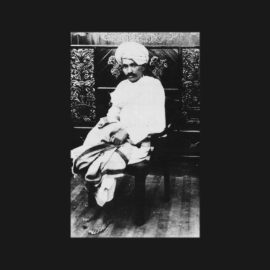

This article is an excerpt from the Shortform book guide to "The Silk Roads" by Peter Frankopan. Shortform has the world's best summaries and analyses of books you should be reading.
Like this article? Sign up for a free trial here.
What role did the East play in world history? How has the dynamic between East and West evolved over the millennia?
According to historian Peter Frankopan, the Silk Roads have always been history’s crucial connection point. He examines the history of Central and Western Asia and its centrality to what has happened all over the world since the dawn of civilization.
Keep reading for an overview of The Silk Roads by Peter Frankopan, which provides a fresh perspective on world history.
Overview of The Silk Roads by Peter Frankopan
In The Silk Roads, Peter Frankopan identifies Central and Western Asia—which he defines as the region between the Mediterranean and the Himalayas, encompassing the Eurasian steppes and the Middle East—as the crossroads of human civilization. Frankopan writes that this area has been the birthplace of the world’s major religions, the battleground where the great empires of history rose and fell, and the garden from which today’s global economy first sprouted.
In ancient times, trade routes known as the Silk Roads (so called because silk—as a durable, non-perishable, highly valued, and easily transported good—was used as a medium of exchange) first brought European merchants to the luxury markets of the East, enabling the flow of both material goods and ideas from East to West. The Silk Roads spread not just luxury goods like silk and spices, but also technology, religion, languages, cultures, ideologies, and even conflicts and diseases.
We explore Frankopan’s history of the Silk Roads chronologically, looking at:
- The beginning of the Silk Roads in ancient times
- The rise of Islam in the Arabian peninsula in the 7th century CE and its impact on the world
- The emergence of Western Europe as the world’s preeminent power center in the early modern period, beginning in the 15th and 16th centuries
- The centrality of the Middle East and Asia in the great conflicts of the 20th century, from the two world wars to the Cold War
- The decline of the West in the late 20th and early 21st centuries and the reemergence of Asia as the center of gravity of global politics and economics
| Critical Reaction to The Silk Roads The Silk Roads received a mixed critical reception when it was published in 2015. A review in The Guardian noted that Frankopan’s work was often insightful and provided a good entry point for a general audience seeking to learn more about global history. However, the same review also criticized the book for placing disproportionate emphasis on certain historical periods and geographical regions at the expense of others—the book, for example, pays little attention to China, Japan, and East Asia in general. Moreover, the Guardian reviewer also noted several factual and contextual errors made by Frankopan: for example, failing to mention the Jews killed by allies of the prophet Muhammad in the wake of his conquests, incorrectly claiming that the Crusaders succeeded in capturing Aleppo (they didn’t), and attributing the capture of Aqaba by the Allies in World War I to the sole work of British agent T.E. Lawrence (better known to history as Lawrence of Arabia). A review for the London School of Economics praised the book for its willingness to challenge Eurocentric views of history. However, that review also gave the book relatively low marks for its lack of analytical insight and de-emphasis of Asian peoples and societies outside of Persia. |
Part 1: The Ancient World and the Beginning of the Silk Roads
Frankopan writes that a defining feature of the ancient world was the rise and fall of large, multicultural, multiethnic empires. These great empires competed with each other for control over the Central Asian and Middle Eastern heartlands, which, because of their abundant natural resources and strategic location, were these empires’ main sources of economic and military strength.
The Persian Empire
The ancient Persian Achaemenid Empire (centered upon the area that is now Iran) first came to prominence in the 7th century BCE. Because of its strategic location, Persia became the crossroads between East and West and the empires of Rome and China. This strategic location would place Persia, and later, the modern nation of Iran, in a starring role on the world stage for centuries.
The Conquests of Alexander
Alexander’s military prowess made him the master of the largest land empire the world had ever known up to that point. His stunning conquests established the expansive Macedonian Empire, which spread Greek and Western Mediterranean culture into Persia, India, and Bactria (modern-day Afghanistan).
Frankopan argues that the movements of Alexander’s armies added to the rich tapestry of language, religion, and culture in this region. This cross-cultural exchange went both ways.
Rome Looks Eastward
Frankopan argues that it was Rome’s seizures of the rich lands of the East in Egypt and Western Asia in the first century BCE that transformed it into an imperial superpower. In the wake of Rome’s conquests, Roman merchants carved out new trade networks that extended to India and Southeast Asia.
Frankopan notes that the emperor Constantine (272-337 CE) strengthened Rome’s ties to the East in two important ways. First, he moved the capital of the imperial government east to Constantinople (present-day Istanbul). Second, he was the first emperor to convert to Christianity, marking the beginning of the process that would make Christianity the official religion of the empire.
The conversion of the Roman Empire to Christianity represented another influence of the East upon the Roman West, writes Frankopan. Christianity, although synonymous today with the West and Europe, was wholly Asian in origin, with its earliest communities based in Persia, Afghanistan, Jordan, Armenia, and the Caucasus. In fact, the East would remain the focal point of Christianity for centuries afterward.
The Dark Ages in the West
By the mid-5th century, the Roman Empire was replaced by a patchwork of barbarian kingdoms. This was the beginning of the so-called Dark Ages in Western Europe, which saw the population drop precipitously, literacy rates collapse, the disappearance of the integrated global economy, and a sharp decline in the standard of living.
Part 2: The Rise of Islam
Frankopan writes that the rise of Islam in the Arabian peninsula would once again prove in spectacular fashion that the East—in this case, the lands that comprise the modern Middle East—was the center stage in global religious, political, and cultural developments.
Islam’s Popular Appeal and Military Success
Islam attracted followers by appealing to Arab tribal solidarity, emphasizing the common interests and experiences of the tribes of southern Arabia—in marked contrast to the powerful neighboring Byzantine and Persian Empires, both of which sought to control and dominate the region by playing local tribes against one another. Islam also attracted local adherents through its roots in the Arabic language, while its relative tolerance of religious minorities helped the new religion win crucial allies.
Stunning military success further convinced people of the power of the new religion, as Muhammad’s armies conquered the overextended and weakened Persian state in the early seventh century and seized North Africa, the Iberian Peninsula, and the Balkans.
The Wealth of Baghdad
Muhammad’s armies founded Islamic states—known as caliphates. It was the third caliphate—the Abbasid Caliphate, centered on the wealthy and cultured new city of Baghdad—that linked together the wealth of Central Asia, North Africa, and Southeastern Europe, creating a new network of trade and tribute. Frankopan writes that Baghdad was the cultural, scientific, literary, and artistic center of the Islamic world in the eighth and ninth centuries.
The Crusades: New Connections Between East and West
As Frankopan writes, the success of the Muslim conquests and the subsequent rise of powerful Muslim states threatened the Christian Byzantine Empire. In 1099, the Byzantine emperor, via the pope, appealed to the Catholic Christians of Western Europe for aid.
This was the beginning of the Crusades—the centuries-long religious struggle waged by European Christians against the Muslim states of the Middle East for control of the Holy Land.
Thanks to the conquests of the Crusaders, Frankopan argues, Europeans gained new access to the rich markets and trade routes of the East, and European scholars marveled at the scientific, literary, theological, and cultural achievements of the Muslim world.
Moreover, the Crusades shook Western Europe out of the isolation in which it had languished since the fall of the Western Roman Empire and gave the new, rising monarchs wider ambitions about their role in the world. Thus, writes Frankopan, the Crusades helped lay the groundwork for the European global imperialism that would follow in the centuries to come.
Part 3: The Emergence of Europe
With the Christian West’s emergence onto the world stage in the wake of the Crusades, Frankopan writes that new European powers began to assert their dominance in Asia and the Middle East as the Middle Ages gave way to the early modern period.
The Bubonic Plague
As Frankopan notes, the Silk Roads didn’t just bring new luxury goods from the East to the West. The new trading networks also brought terrifying diseases like the bubonic plague. According to Frankopan, the resulting depopulation in Europe led to a major shock to the labor supply—the sudden scarcity of labor boosted wages and bargaining power for those who managed to survive the plague, forcing landlords to lower rents and reduce many of the repressive and onerous restrictions of the feudal economy. This gave European peasants and artisans new disposable income, boosting demand for goods, and, according to Frankopan, beginning Europe’s global economic dominance.
The Decline of Spain and the Rise of England
The Iberian kingdoms of Spain and Portugal dominated the European political scene in the 16th and early 17th centuries, thanks to their early discovery, conquest, and exploitation of Central and South America. But, while this influx of money financed Spain’s lavish military campaigns across Europe, it also sparked massive inflation. These economic woes led Spain to repeatedly default on its foreign loans, precipitating its decline as a world power.
The decline of Spain, argues Frankopan, opened the door for the economic center of Europe to shift north and west to the British Isles by the 17th century. The English secured new trading outposts on the Indian subcontinent and established burgeoning colonies on the Atlantic coast of North America. This was the germ of the soon-to-be mighty British Empire.
New Great Powers Clash in the East
Frankopan writes that, with the rise of the expansive Russian Empire beginning in the early 19th century, Russian influence would extend into Central Asia, Afghanistan, Kazakhstan, and Persia—dangerously close to India, now the crown jewel of the British Empire. The British settled on a policy of accommodating Russian ambitions in Central and Eastern Europe—effectively giving the Russians a freer hand in their competing territorial claims with Germany in exchange for Russia limiting its expansionist aims in Asia.
Britain’s strategy to appease Russia would come at the expense of souring British relations with the rising and powerful German Empire. Frankopan argues that this maneuvering by the British played a decisive role in marching Europe and the world toward World War I—all to protect British interests in Asia.
Part 4: Into the Modern Era
World War I would forever alter the international order, according to Frankopan. The old colonial empires of Britain and France, although victorious in the war, emerged greatly weakened, while the old multinational empires of Russia, Germany, Austria-Hungary, and the Ottomans collapsed altogether. Out of the ashes of the devastating conflict would arise new international economic, political, and military rivalries that still dominate our world today. But the root of these power struggles would remain where it had been for centuries—in the East.
Oil Politics
Persia had been coveted by the great powers of East and West due to its material wealth and strategic location. But the discovery of oil there in the 19th century would once again make Persia the center stage of global politics.
Frankopan writes that, in the early 20th century, the British secured exclusive access to Persian oil resources. This would prove decisive to British victory in World War I. To protect their access to oil, which they saw as the lifeblood of the empire, the British after World War I set up puppet governments and figurehead leaders all across the Middle East, redrawing national boundaries to get the pliant political arrangements they desired. These moves fueled nationalist and religious resentments that would boil over in the decades to come.
World War II
According to Frankopan, the East would once again prove to be the hinge upon which global politics swung. Aggressively expansionist, the Nazis sought to conquer the rich agricultural lands of Eastern Europe and the oil-producing regions of Western Asia and the Caucasus.
Nazi agents and industrialists had made important technological, economic, and political inroads in the Middle East and Western Asia during the 1930s, with much of the population seeing Germany as a trusted friend and counterweight to British influence—aided in no small part by shared antisemitism between the Nazi operatives and local Islamic elites.
The US and the Postwar World
The human and economic toll of World War II would significantly reshape the postwar political order. After the war, the US and the Soviet Union would emerge as the world’s two rival superpowers. Both superpowers jockeyed with one another for position in countries like Iran and sought to curry favor with the local ruling elite in these countries, usually by helping to fund lavish military and infrastructure projects.
Cold War Politics
Frankopan writes that, for the US, protecting what it saw as its vital strategic interests in Asia against Soviet encroachment trumped any high-minded ideals about democracy or human rights. The Americans financially and militarily supported pro-US—but corrupt and autocratic—regimes across the Middle East, Central and Western Asia, and the Pacific.
Part 5: The Decline of the West and the Resurgence of the East
Although the US and Soviet Union emerged from World War II as the world’s superpowers, the East would begin to reassert its political centrality and chart its own destiny in the latter third of the 20th century and into the 21st.
Oil Shocks of the 1970s
Nearly all Western economies were highly vulnerable to oil supply shocks. In 1973, the Arab members of the Organization of Petroleum Exporting Countries (OPEC) imposed an oil embargo on all the countries that had supported Israel in the just-concluded Yom Kippur War. This led to massive oil price hikes and inflation in the United States and Western Europe.
Western Meddling Backfires
The political meddling by the United States and other Western powers in the Middle East and Asia during the 20th century would come back to haunt them in the 21st century. He cites Afghanistan as an example, as it became a safe haven and training ground for militant jihadist organizations.
The 9/11 Attacks and the War on Terror
Frankopan writes that history had truly come full circle on September 11, 2001, as Al Qaeda invoked the legacy of the Crusades and Western/Christian meddling in Asia as a justification for its violent anti-Western ideology and tactics. The US sought revenge and began a project to entrench US military and political dominance in Asia and the Middle East once more. Frankopan argues that these wars produced little value for the US and its allies.
Power Shifts East Once Again
Frankopan argues that these recent developments show that history is reverting to its old norm—the fulcrum of global power is moving from West to East once again, after its relatively brief historical aberration over the last few centuries. Asia and the Middle East, he observes, are the center of gravity of the world’s rising population and most valuable natural resources. Any instability in this crucial region upsets the world order. The goods being traded and the resources being contested may be different from those in ancient times, but the strategic location would not have been unfamiliar to Alexander the Great—because they are the Silk Roads of old.
| The Pivot to Asia Some Western political leaders have argued that the rise of Asia—and, in particular, the growing economic, cultural, and military power of China—is a sign that the US and Europe should shift their primary geopolitical focus eastward toward Asia. Notably, in 2011, President Barack Obama declared that the US was a Pacific power and that it intended to engage more closely with Asia. The administration dubbed this the “Pivot to Asia,” and the Biden administration has taken up its mantle in the 2020s—by disentangling the US from the War of Afghanistan; seeking inclusion in the Trans-Pacific Partnership trade deal; and strengthening the informal strategic security dialogue between the US, Japan, Australia, and India known as “the Quad,” to act as a counterweight to China. |
Exercise: Understand The Silk Roads
Reflect on Asia’s pivotal role in world history.
- Why do you think Asia has exerted such a powerful influence on global geopolitics since ancient times?
- Do you think the current rise of Asia and the decline of the West outlined by Frankopan is a positive or negative development for global security and stability? Explain why.
- How do you think Western leaders can more constructively engage with Asia? Explain your answer.

———End of Preview———
Like what you just read? Read the rest of the world's best book summary and analysis of Peter Frankopan's "The Silk Roads" at Shortform.
Here's what you'll find in our full The Silk Roads summary:
- Why the Silk Roads have always been history’s crucial connection point
- Why understanding the East is crucial to our understanding of the world
- A history of the Silk Roads, from ancient times to the 21st century






